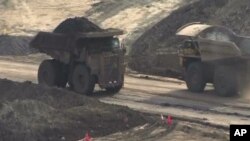U.S. politicians often speak of reducing the nation's demand for imported oil from unfriendly nations. But the biggest foreign supplier of oil to the United States is Canada, a friendly nation on the northern border. Much of the 1.4 million barrels of petroleum Canada sends south each day comes from the so-called "oil sands."
Most people think of oil being pumped out of the ground, but here in Alberta much of it is mined. The largest shovels, cranes and hauling trucks on earth operate in huge pits to extract the mucky material, which is trucked to nearby up-grader plants so bitumen can be cooked out of the clay, sand and other material.
Anne Marie Toutant is Vice President of Mining Operations for Suncor Energy, one of the Canadian companies that has been working here for several decades. She says bitumen needs special treatment.
"It is an oil-based, long-carbon-chain product that, through the extraction and separation process and then the upgrading process, we make it into smaller chains, useful products for automobiles and other transportation methods," said Toutant.
Watch Part 1
Watch Part 2
About 22 percent of the oil imported by the United States comes from Canada and most of it comes from bitumen in oil sands. Canada has more than 170 billion barrels of proven oil sands reserves that can be extracted either through mining or in-situ plants, which pump hot steam into the ground to melt the bitumen so that it can be drawn out.
Tountant says new technologies may one day open an even bigger bonanza here.
"There are probably technologies we do not know about yet," Toutant added. "There are over a trillion barrels of oil up here and less than 20 percent of it can be exploited through the in-situ and mining technologies we have today."
But the oil sands industry has come under increasing attack from environmental groups who complain about water and ground contamination, high instances of cancer in some communities downstream and the production of three times the amount of greenhouse gases as conventional oil operations.
In an effort to counter such criticism, companies like Suncor have taken steps in recent years to reduce emissions and clean up huge toxic tailings ponds that hold mine residue mixed with water. A new technology that utilizes a polymer to clump clay together and help disperse water has speeded up the process.
Suncor's Chief Executive Officer and President Rick George, was on hand last month for the inauguration of a tree-studded field that once was an unsightly pond full of tainted water. He says this is an expensive, but necessary part of operating here.
"The normal operating basis is to reclaim these ponds all back to a dry state so that when you come out here a decade from now, you will not even know this was actually ever a mined area," said George.
But environmental writer Andrew Nikiforuk, author of the book Tar Sands, Dirty Oil and the Future of a Continent, says such reclamation does not leave the land the same as it was before.
"Fifty percent of the landscape that has been disturbed were wetlands and we have no plans, at this point in time, to replace those wetlands, because, number one, we do not know how to do it, and number two, the economic cost of doing so would be extraordinary," said Nikiforuk.
About 80 percent of the oil sands remain beyond the reach of mining and are developed with the in-situ method, which has far less impact on the land surface. But Nikiforuk says the in-situ plants use too much energy, in the form of cleaner burning natural gas, and too much water to make steam.
He says citizens of both Canada and its principle customer, the United States, need to be aware of the environmental costs of developing oil sands.
"This project has placed both Canada and the United States, who are dear friends, in an awkward position, where we have now replaced Saudi Arabia as the number one purveyor of oil [to the United States] and we have taken on a number of Saudi characteristics, in the sense that we are not being totally honest about how dirty this whole project is," added Nikiforuk.
But some U.S. politicians have declared the northern neighbor's oil sands a godsend that could help drastically reduce the need for oil from the Middle East and elsewhere. Alberta officials argue the oil sands are a resource that has enriched the province and Canada as a whole and that they can be exploited responsibly.
Environmentalists like Andrew Nikiforuk say development of the oil sands should be slowed down. He says the deposits should be treated as an important resource to use during the transition to a cleaner energy future characterized by renewable energy and increased conservation.
Most Canadians favor the economic benefits the oil sands provide, but they also want greater attention to environmental concerns. The trick will be finding that balance as companies from around the world come here to exploit what may be the world's last great petroleum play.







